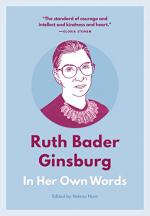
|
| Name: _________________________ | Period: ___________________ |
This test consists of 15 multiple choice questions and 5 short answer questions.
Multiple Choice Questions
1. According to Ginsburg’s husband, who was a law school teacher, whose hand would shout up first to answer a question?
(a) A female’s.
(b) A male’s.
(c) A smart student’s.
(d) An older student’s.
2. Who said, “If Ruth and I came of age in a time when there was no discrimination against women, we would be retired partners in a major law firm”?
(a) Celia Bader.
(b) Florence Allen.
(c) Martin Ginsburg.
(d) Sandra Day O’Connor.
3. From where did Ginsburg receive her undergraduate degree?
(a) Cornell.
(b) Harvard.
(c) Yale.
(d) Princeton.
4. Who was Ginsburg’s biggest booster?
(a) Her mother.
(b) Her father.
(c) Her daughter.
(d) Her husband.
5. Why does Ginsburg believe Supreme court judges are infallible?
(a) Because Supreme court judges completely understand the law.
(b) Because Supreme court judges have short appointments.
(c) Because Supreme court judges are appointed for life.
(d) Because Supreme court judges are intelligent.
6. What type of argument is very important, because it is the first time all nine justices are thinking about issues together?
(a) Deductive argument.
(b) Written argument.
(c) Inductive argument.
(d) Oral argument.
7. What did Ginsburg’s husband admire most about her?
(a) Her kind heart.
(b) Her loud voice.
(c) Her intelligence.
(d) Her strong will.
8. Does Ginsburg believe it is ideology that keeps lawyers from helping to repair tears in their communities, nation, and world?
(a) No, not in general.
(b) Yes, in general.
(c) Sometimes.
(d) Often.
9. Who did the Founding Father believe bestowed human rights?
(a) No one.
(b) A Higher Authority.
(c) Kings and Queens.
(d) The leaders of the nations.
10. What does Ginsburg say is the benefit of having judges with diverse backgrounds and experiences?
(a) Our system of justice is too diverse
(b) Our system of justice struggles to find agreement.
(c) Our system of justice does not function as easily as it used to.
(d) Our system of justice is surely richer.
11. Every modern human rights document has what statement?
(a) Men are equal before the law.
(b) Men and women are treated differently before the law.
(c) Men and women are equal before the law.
(d) The laws do not apply to the wealthy.
12. What is the reason that Ginsburg gives for why the press seldom talks about the high level of agreement among all of the justices?
(a) Only the truth mattered to the press.
(b) Agreement is kind of boring.
(c) They do not pay much attention to the judiciary branch.
(d) The justices rarely agree.
13. What phrase was Ginsburg known to say often?
(a) That is not Constitutional.
(b) Free to be you and me.
(c) I object.
(d) I know what is best.
14. Who recognized Ginsburg’s keen sense of justice when he appointed her to the U.S. Court of Appeals for the District of Columbia Circuit?
(a) President Jimmy Carter.
(b) President George Bush.
(c) President Richard Nixon.
(d) President Ronald Reagan.
15. Where and when was Ginsburg born?
(a) Queens in 1943.
(b) Boston in 1933.
(c) Chicago in 1923.
(d) Brooklyn in 1933.
Short Answer Questions
1. Most men of the bench and bar had what the French call what, regarding the unyielding conviction that women and lawyering do not mix?
2. What is far more important than the particular individuals who compose the Court’s bench at any given time?
3. What does Ginsburg see as the principal mission of the Supreme Court?
4. When Ginsburg enrolled at Harvard Law School, she was one of how many women in a class of 500 students?
5. What is an activist judge, according to Ginsburg?
|
This section contains 630 words (approx. 3 pages at 300 words per page) |

|




